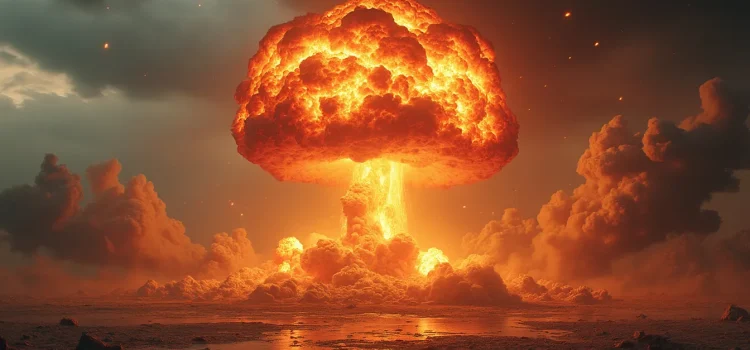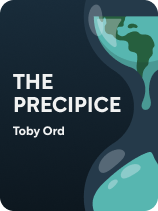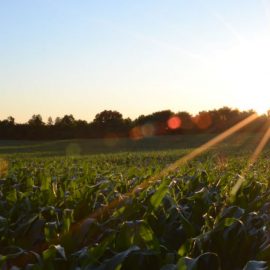

This article is an excerpt from the Shortform book guide to "The Precipice" by Toby Ord. Shortform has the world's best summaries and analyses of books you should be reading.
Like this article? Sign up for a free trial here.
Are we on the brink of a human-made disaster? What catastrophic threats to our existence could be our own fault?
Toby Ord’s book The Precipice explores the dangers posed by anthropogenic threats. He speculates on the potential consequences of nuclear weapons, climate change, and environmental damage. These human-driven risks could lead to civilization collapse or even extinction.
Keep reading to get Ord’s take on these potential existential challenges.
Anthropogenic Threats
In his book, Ord discusses existential anthropogenic threats—potential catastrophes brought about by human actions. He highlights three major types of such threats: nuclear weapons, climate change, and environmental damage.
Nuclear Weapons
First, Ord explains that nuclear weapons threaten humankind because they have the power to cause a civilization collapse, and we haven’t handled this technology wisely. Ord notes that even when scientists thought a nuclear bomb could consume all the water from the oceans or ignite the nitrogen in our air and engulf the earth in flames, the US still went ahead with the nuclear attack on Hiroshima during World War II. And while these effects didn’t occur, the explosion and fallout of the attack killed many tens of thousands. Despite our knowledge of these devastating effects, there have still been three close calls of nuclear attacks since then.
Ord explains that a nuclear war could lead to civilization collapse and even human extinction due to radioactive fallout—when the bombs go off, fires engulfing entire cities would produce enough smoke to reach the stratosphere where it’s too high to be rained out. It would then block the sunlight, leading to a nuclear winter that would kill crops and lead to starvation for billions. Further, Ord explains that if we increase our nuclear arsenal to 10 times what we currently have, the radioactive fallout of nuclear war could cover the entire earth.
However, Ord suggests that while billions may starve, human extinction is unlikely. In such desperate times, humanity might resort to alternative food production methods like planting cold-tolerant crops or farming algae. Despite this glimmer of hope, he acknowledges many uncertainties surrounding our understanding of a nuclear winter’s impact and calls for further research on this topic.
Climate Change
Ord explains that the second major existential anthropogenic threat is climate change. Our atmosphere and its balance of gasses provide the planet with a stable temperature and pressure that allows life to thrive. When this balance gets thrown off, for example by human carbon emissions, the effects could eventually make Earth uninhabitable.
First, Ord explains that climate change could produce an existential catastrophe due to “feedback effects”—phenomena that accelerate the current rate of global warming. For example, as the planet warms, arctic permafrost (a layer of frozen rock and soil that contains massive amounts of carbon) melts and releases its stored carbon. This release would further accelerate warming.
Ord explains that another way climate change could lead to an existential catastrophe is if humans simply release more emissions. Our emissions are estimated to double and raise the global temperature by up to 4.5°C by 2100. A warming of 6°C would produce extreme effects, and a warming of 13°C—which Ord says is very possible by 2300—would likely produce existential catastrophes.
At an increase of 13°C, says Ord, we’d face reduced agricultural yields, sea level rises, water scarcity, increased tropical diseases, and ocean acidification. Most critically, it would lead to heat stress—in certain regions, the climate and humidity would be so high that we’d be unable to cool our bodies by sweating, and therefore wouldn’t be able to survive. Making matters worse, the regions that would become uninhabitable house half the population and produce much of our food—other regions would become overcrowded due to forced migration, and our food supply would be extremely reduced.
Environmental Damage
While many people believe that environment-damaging issues like overpopulation and resource depletion threaten the survival of humanity, Ord says these really aren’t areas of concern—the rate of population growth has been decreasing since the 1960s, and science shows we have more than enough resources. The most concerning form of environmental damage to our survival as a species is biodiversity loss.
(Shortform note: While Ord notes that the population isn’t a threat to our survival because it’s declining, this decline might be threatening for another reason. Some analysts contend that population decline leads to a lack of innovation, and we’re going to need breakthrough innovations to figure out how to prevent, mitigate, and survive the catastrophes Ord discusses. This lack of innovation would also negatively impact the global economy.)
The current rate of species extinction is significantly higher than the historical average. It’s difficult to tell whether this signifies the early stages of a mass extinction, but the phenomenon is deeply troubling nonetheless. While less extreme than species extinction, population losses and regional disappearances of certain species severely impact ecosystem functions that benefit humans like water purification or enhancement of soil quality. While it’s hard to say, Ord says that at some point these issues could impact food production leading to an existential catastrophe.
| Scientists’ Views on Biodiversity Loss and Population Growth Scientists agree on the pressing issue of biodiversity loss due to human activities; however, while Ord is unsure whether this indicates mass extinction, many firmly argue that we’re already facing the sixth mass extinction. Further, while Ord mentions population growth and resource depletion as less pressing than biodiversity loss, other scientists contend that human population growth, particularly since the agricultural and industrial revolutions, is one of the main causes of the unprecedented extinction rates at hand. Population growth means more humans to feed, clothe, and house. This development contributes to biodiversity loss not just through pollution and climate change, but also through habitat destruction (for houses, stores, factories, and so on), overhunting and overfishing to feed the population, and the forced relocation of invasive species to new ecosystems. |

———End of Preview———
Like what you just read? Read the rest of the world's best book summary and analysis of Toby Ord's "The Precipice" at Shortform.
Here's what you'll find in our full The Precipice summary:
- How an apocalypse that ends humanity is possible
- How we can still prevent an existential catastrophe
- The three most likely species-ending events in the future






